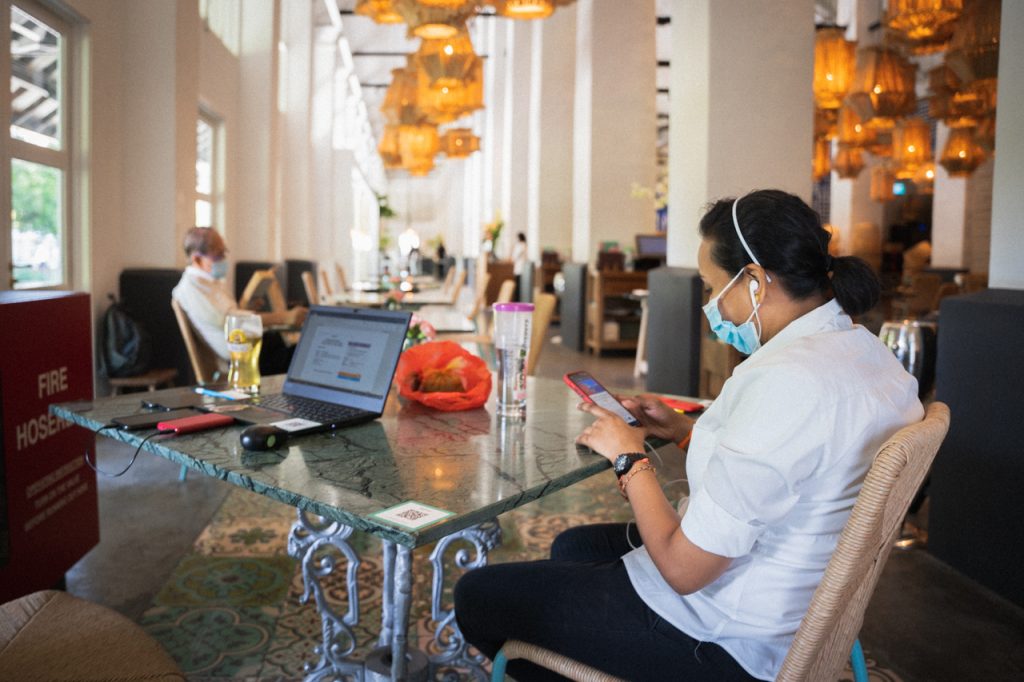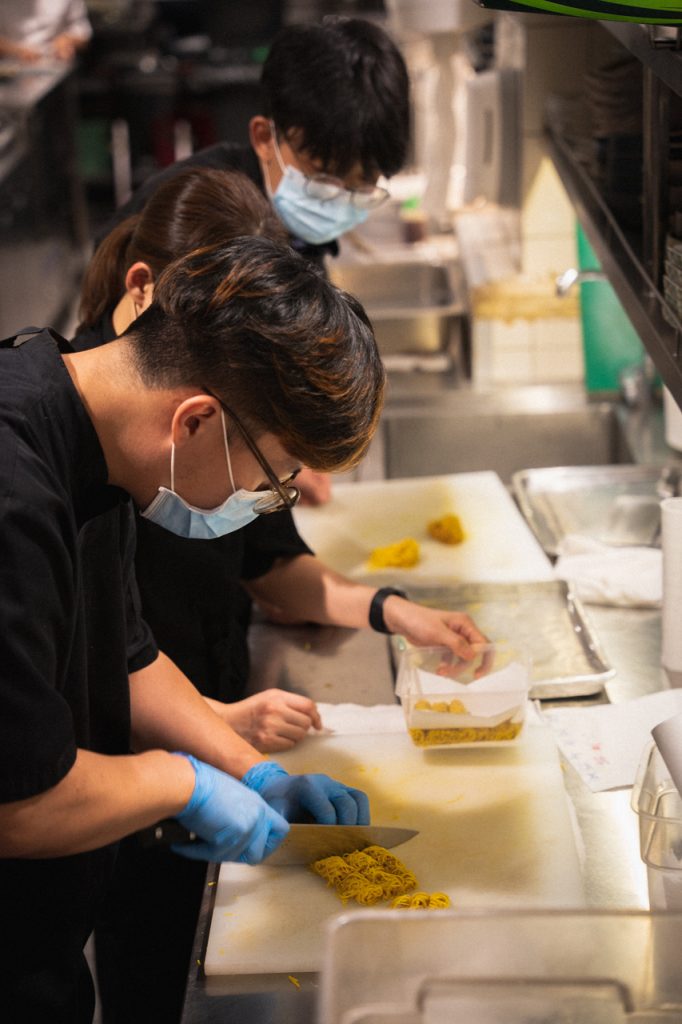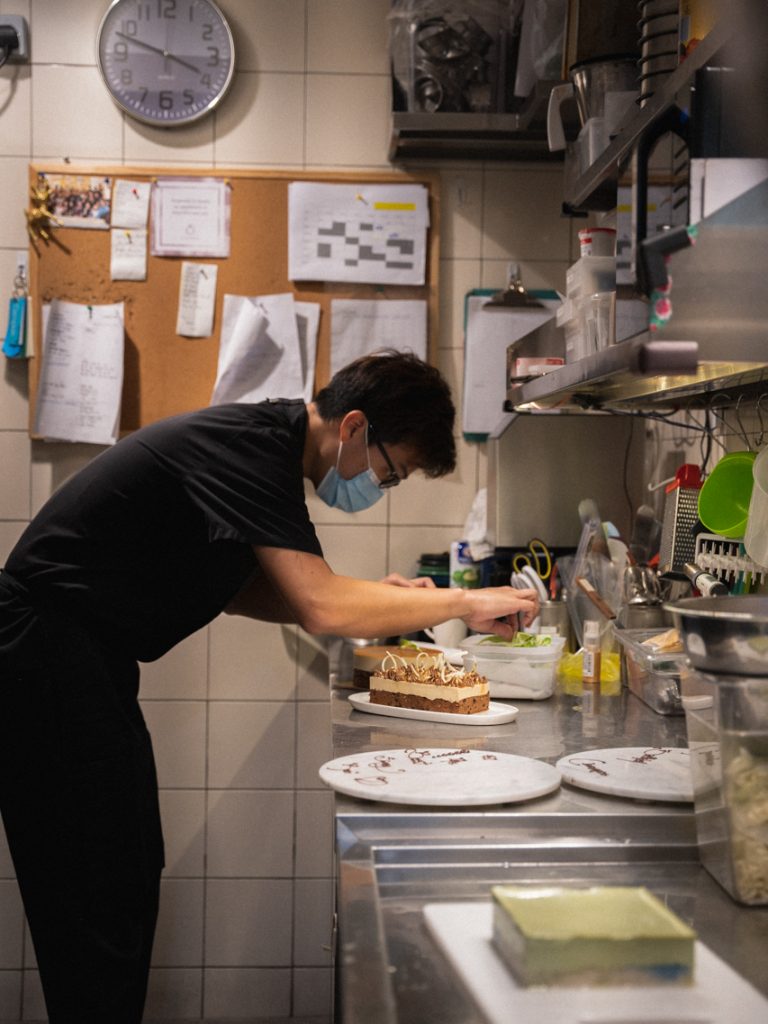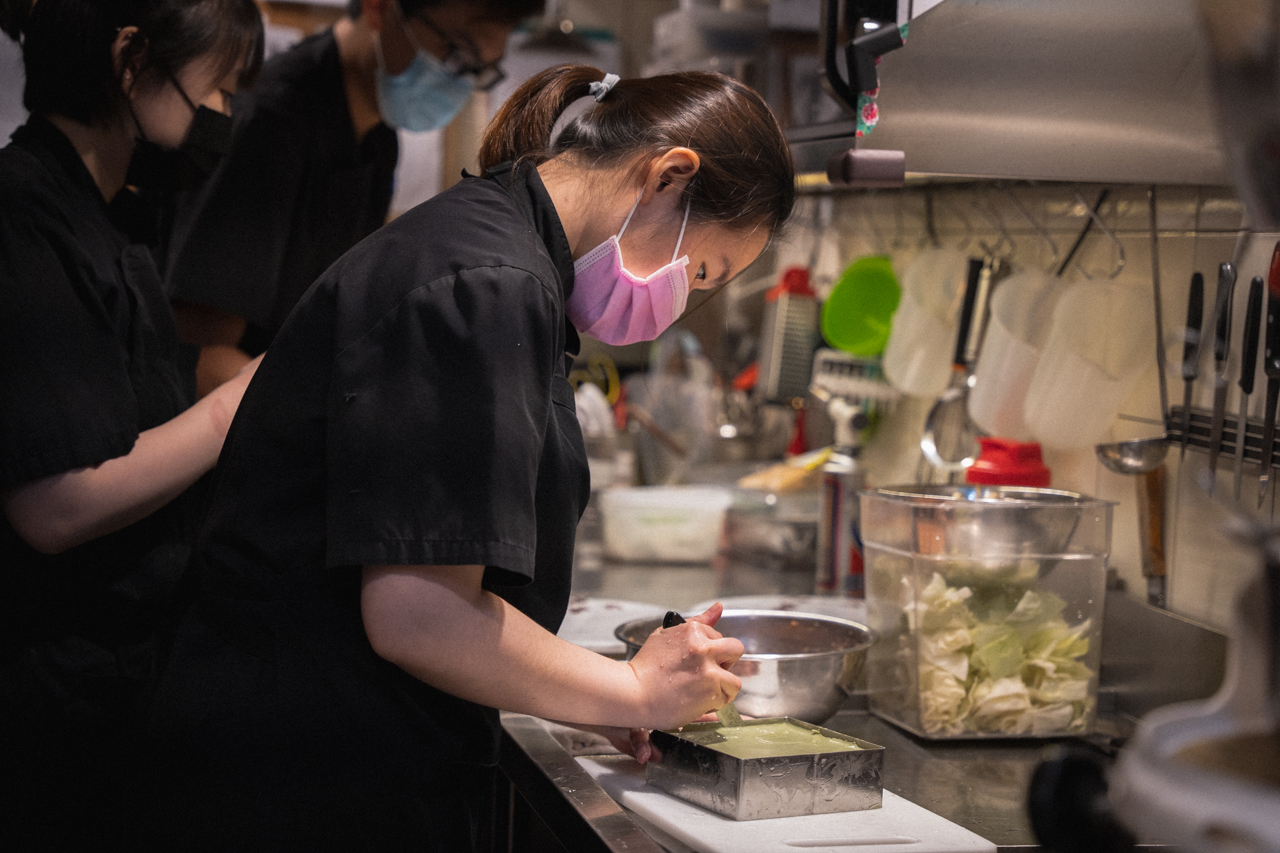This article is part of our series on burnout and work culture, Running on Empty. Stay tuned for the next video episode coming later this month.
Images by Zachary Tang save where otherwise stated.
It was October 2016, and Malcolm Lee was meant to be having the time of his life. His restaurant, Candlenut, had just been awarded one Michelin star, becoming the first Peranakan restaurant in the world to receive the honour. The day he got the call passed in a whirlwind of revelry—the gala dinner at Sentosa, followed by celebratory hor fun, champagne, and partying late into the night—but deep down, he was miserable.
“Right through the day that we received the call and collected the award, I felt nothing,” he recalled. “It’s not that it’s not important or we weren’t happy to receive it, but there was this emptiness in my heart. It sounds cheesy, but it’s true.”
Years of striving to put Candlenut on the map had hollowed him out. Since opening the restaurant in 2010, his days had coalesced into 14 to 16-hour blurs, beginning with 8:00AM marketing trips and stretching past 1:00AM, seven days a week. After dinner service ended, there was still the next day’s prep to take care of, meetings to settle, and budgets to balance.
He started running on coffee to get everything done, followed by sleeping pills to unwind. His mental health nosedived. Then his relationship fell apart.
Seeking a distraction, he threw himself into preparing for Michelin. But with the award now in hand, he found himself wondering: had it been worth the cost?
“I started thinking, maybe we over-glorify these long hours in F&B. Everyone talks about working 14, 16 hours a day like it’s something to be proud of, it sounds very macho, and it’s quite acceptable in our industry. But you just work, go home, sleep, and carry on. You can do it for a few months, maybe a year, but when you stretch it for many, many years… you lose a lot of things during that time.”
With that, he made up his mind: no more losses. Shortly after the restaurant moved to new premises in Dempsey, he put all his kitchen staff on a four-day workweek.

The four-day workweek: more aspiration than actual reality
In the five years since, the four-day workweek has been gaining momentum. This week, Iceland published the results of a yearslong trial (overwhelmingly positive), while organisational psychologists like Adam Grant are ardent believers in the cause.
Outside of Northern Europe and the wealthiest tech companies, however, the four-day workweek remains the stuff of utopian fantasy.
In Singapore, only a handful of businesses—mostly tech MNCs—have begun to implement flexi-work arrangements. The most radical practices, like ‘right to disconnect’ laws, unlimited leave, and the four-day workweek, are so distant as to be inconceivable. Much as the pandemic has turned the spotlight on the relationship between work, mental health, and business practices, in reality, many more employees dream of better work-life balance than companies working to accommodate this.
Hearing that Candlenut had adopted the four-day workweek years ago was enough to intrigue me, but it stands out all the more when you consider that work-life balance is mostly discussed in the context of white-collar work. Although overwork affects delivery riders and ad execs alike, no-one talks of work-life balance for chefs, nurses, or logistics warehouse staff—the essential workers on whom our economy turns.

The F&B industry, in particular, is known for its punishing hours. While arrangements can vary, hours are often, like Hobbes’ Leviathan, nasty, brutish, and (very much not) short.
Most kitchen staff work 5.5 to 6 days a week, including weekends and public holidays. Fast-casual places tend to use ‘straight’ 8-hour shifts, split into lunch and dinner, but many restaurant staff (including hotels) usually spend between 10 to 13 hours on their feet in the kitchen, with a break in between.
Example A: Choon, one of Candlenut’s pastry chefs, described his schedule at the hotel he previously worked at. He used to work the bakery shift, which started at midnight and ended around 8:30AM the following day. “So that’s your off time. Then you rest and come back that night,” he explained. He worked this six days a week.
The pastry team had three chefs, but as two were needed in the kitchen at any one time, it was almost impossible to get time off. He had no life outside work. “It’s why so many cooks are single,” he joked.
The opportunity costs spill over into cooks’ professional lives, too. Culinary school seldom covers non-kitchen skills like business and marketing, making it difficult for them to cross over to entrepreneurship, or experiment with learning outside the kitchen.
At Candlenut, Malcolm had come to a similar conclusion. To him, even more pay wouldn’t make up for it.
“You have two trains of thought: some prefer four days, while some would rather work five days and earn more. But I maintain that it can’t be about the money alone, because I could pay everyone more, cut down staff, and go back to five days, but that will just repeat the cycle I don’t want. Maybe you take back a few hundred dollars more, but the emotional stress will come through.”

Making it work
So he just went for it.
“I just cut everyone’s workweek by one day,” he said, grinning sheepishly. “I was very determined, but there was no thought process…maybe it was a little rash or irrational. Like, the schedule is already planned and you just need to cut everyone by one day, right? So literally, the next day, I told everyone they’d have one extra off day.”
Naturally, the staff were delighted, but there were also teething problems. First, the new system meant employees interacted less. Since they could be scheduled on different days, they could sometimes go up to two weeks without seeing one another.
More importantly, to ensure they had enough people in the kitchen on any given day, they needed to hire a lot more staff. “You’re already running very lean, then you take out one day, and you’re like… Woah, what did I do,” reflected Malcolm. “But I was very determined to make it work.”
The restaurant went from a 15 to 16 person team at its old Dorsett location to nearly double that at Dempsey. Its headcount is now around 40, excluding support staff in IT, HR, and marketing, which are provided by the COMO Group, Malcolm’s business partner.
“It’s more expensive to have a four-day workweek,” said Malcolm, who stressed that this was done without cutting salaries. (Staff also receive their full entitlements like annual leave, incentives, and bonuses.) Though he declined to share exact wages, taking into account the smaller number of hours worked per week, his staff are paid at least on par, if not better, than the market rate.
“It’s a fact. Everyone works one less day, so you need more people, but it’s not difficult to implement. It’s just costly.”

Balancing the books — and the question of a fair wage
However, Malcolm couldn’t just argue that the four-day workweek would improve staff welfare. He also had to show it would make business sense. “It’s not like I can go crazy and sacrifice the money side of things, because if I don’t do this sensibly, the restaurant won’t survive,” he pointed out.
According to him, labour is now the largest of the restaurant’s overheads. To balance out the impact on revenue, they had to raise their prices.
“It’s also due to our style of cuisine—this very high-quality, labour-intensive, Peranakan style cooking. You know how long my mum and grandma take to prepare a meal for 20 people? Here, we’re doing it at a much larger scale.” (I did wonder if this, along with Candlenut’s positioning as a premium establishment, made the price increases an easier sell. Not every restaurant is able to charge $20 for ngoh hiang, after all.)
However, Malcolm stressed that customers aren’t just paying for first-rate ingredients, but that the higher prices also help make the extra time off possible for staff. In other words, Candlenut’s menu is not being cross-subsidised by poor wages and working conditions.

From a quick scan of jobs boards, basic pay for an entry-level cook starts around $1,600. More senior cooks with a few years’ experience earn in the region of $2,500. This is significantly below the median: according to MOM data, the median gross monthly income from work in 2020, including CPF, was $4,534.
Choon, the pastry chef, showed me his payslip from the hotel he used to work at in 2016. As a chef de partie with about four years’ experience, his basic wage was $1,730.50, rising to a total take-home amount of $2,034.50 with overtime and back pay. For this, he was working 10 to 12 hours a day, six days a week. (At Candlenut, he now works 10 to 12 hour shifts in blocks of two days, followed by two days off.)
Although wage increases may be on the horizon, with the expected rollout of the Progressive Wage Model (PWM) to the F&B sector, it’s unclear whether this will tackle the issue of work-life balance. It’s one thing to ensure workers are paid better wages; it’s another to ask whether those wages are fair, given the sheer number of hours worked and the toll this can take—not just on general well-being, but on physical and mental health.
“It’s not like we’re charging a premium to cheat your money,” stressed Malcolm.
“First, you’re paying more for this rendang because of the quality ingredients. Second, you’re supporting the industry to get out of this cycle. This encourages business owners to say, look, we have this pool of money we can use to give our team a better working environment. ”

Staff reviews
Beyond improving staff welfare, the four-day workweek has helped with retention rates. In Malcolm’s view, the higher costs are also justified by consistent service and food quality, as well as time saved training new staff.
“I’m very thankful that many of my staff have been here for years. It makes me less stressed too because if I always have new people, I need to be in the kitchen to guide them,” he remarked. “Also, it reduces things like people taking MC, coming up with excuses not to be here…There shouldn’t be any of these things when we create a good working environment.”
Choon, for his part, declared himself “very happy” with where he is. He’s worked at four restaurants over 10 years in F&B, spending the last five of these at Candlenut.
“Honestly, it’s very good for Singapore F&B line,” he told me. “Not many places have three days off. You can rest more, have more energy, use the time to learn new things.” He uses his time off to catch up on rest and take pastry masterclasses.
Pamelia Chia, the author of the best-selling Wet Market to Table, shared that the four-day workweek allowed her to write her cookbook. (She worked at Candlenut before moving to Australia in 2018.)
“Having more time off meant I could spend more time learning about dishes or cuisines beyond the confines of a menu,” she told me over e-mail. “It was also because of this that I was able to write my cookbook. It was pretty intense and I don’t think I could have met my manuscript deadline if I was a chef or office-worker doing five-day work weeks.”
Dennis, a cook at Candlenut’s curry station, agreed. He did a traineeship at Candlenut in 2019 before moving to a French restaurant where he worked a 5.5 day week, returning to Candlenut this year. Although he helps out with his family’s catering business on his days off, he claimed to still prefer a four-day workweek to working five days with more pay.
“It’s less tiring, and you get to spend more time with loved ones,” he explained.
When I mentioned Choon’s comment about how many cooks tend to be single, he cracked a small smile. “Most of the guys here are attached,” he said.

Caveats, challenges, and limitations
All the same, Malcolm took pains to emphasise that they haven’t gotten everything right. “It’s not perfect by any means. We’re still learning, and at the end of the day, we’re still a very young restaurant.”
If there are cracks and caveats to be observed, for one, it’s that Malcolm—as the boss— doesn’t strictly follow the four-day workweek himself. When I pressed him on whether he still checked his emails or held meetings outside restaurant hours, he hesitated.
“It’s much better for me now, compared to the early days,” he replied. “Even if the restaurant is running and I’m not here, I feel confident that it’s being run well. But to be honest, I don’t know there’s really four days for me. If it’s urgent and I can’t help it, yes, I’ll answer my e-mails. Mine is more spread out because I have to manage everything.”
Part of Malcolm’s schedule involves non-kitchen work, such as R&D, meetings, and doing press (like this interview). To this end, as many have argued, the four-day week is also easier to implement for industries that keep largely fixed hours, without being beholden to shifting deadlines or third-party schedules. One of the main debates about the four-day workweek—is it better to cram everything into four days, or work five days at a more leisurely pace?—simply doesn’t apply to restaurants.
This said, while Candlenut’s back-end teams like HR and finance aren’t on the four-day workweek, they operate on a core basis of flexibility. (Their service staff are also on a five-day week, though with staggered schedules. The restaurant is also looking into shortening their hours in the future.)
Rachel, Malcolm’s executive assistant, weighed in. Her contract is technically for standard office hours— 9:00AM to 6:00PM—but her real schedule often varies “depending on Malcolm’s orders,” she said, grinning.
“Some mornings I start a bit later, some days I half work from home, some days I pick up again at 10:30PM after Malcolm replies to my messages,” she explained. “He’s given me a lot of flexibility, which is why I’m still here.”
“Give and take, lah,” Malcolm chimed in.
Rachel nodded. “Honestly, the four-day thing doesn’t really affect me because my hours are so different from the ops teams. They work 10 to 10. I do practically half of that, plus I’m not on my feet all day,” she reflected. “It’s a different level of energy and commitment required.”
“Four or five days doesn’t make a lot of difference to me. That one extra day means a lot more for them.”

What’s really the best way forward?
Candlenut, ultimately, is but one example of one workplace in one industry that’s tried one particular method of improving work-life balance. Regardless of what they do, the debates around the four-day workweek will continue.
At its core, though, the four-day workweek isn’t actually about whether four or five day-systems are better. It’s not even about whether productivity should be measured in hours worked rather than days.
What it really is is an attempt to answer some fundamental questions about how we work today, and how our expectations around this are changing. Where should work fit in the matrix of our lives? What makes a good working environment—one which encourages thriving, not merely survival? And ultimately, how can work be approached in a way that meets business’ needs, while respecting employees as people with full lives outside their jobs?
“Apart from the four-day workweek, I think something that Candlenut and Carlton Wine Room (the restaurant I worked at in Australia) do well is implementing proper breaks for staff,” shared Pamelia. “I always find it ironic that hospitality workers don’t always get treated with the same hospitality by their bosses.”
“For me, it’s not about setting an example. Some of my friends who are chefs said this is a bit crazy. Or spoil market,” said Malcolm. “But it’s not that. It’s not even about convincing people to join us. I just feel that this is what I want for our place.”
“I came into this industry because of people. We want people to like our food, to see them smile, but ‘people’ also includes people we work with,” he said.
“If you take care of your team, they’ll feel happier about coming to work. And when they feel happier, that flows out to our guests. That’s where the true spirit of hospitality comes in.”
Note: This article was amended to clarify that Candlenut’s service staff are on a five-day week, and to reflect Rachel’s title as executive assistant.
If you haven’t already, follow RICE on Instagram, Spotify, Facebook and Telegram. If you have a lead for a story, feedback on this piece, or just want to say hi, drop us a note at community@ricemedia.co.







